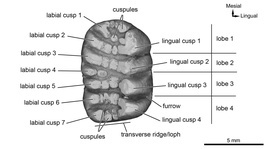Magallanodon baikashkenke: A new species of Gondwanatherian Mammal from the Late Cretaceous of Chile.
[sciencythoughts.blogspot.com]
Even though South America has an impressive fossil record of Cretaceous terrestrial Vertebrates, Mammals are still sparse components of these assemblages. Their remains are known from few localities in the Argentinian Patagonia, as well as from isolated and extremely fragmentary records in Bolivia, Brazil, and Peru. With the exception of two Cladotherian Mammals, Vincelestes neuquenianus (Early Cretaceous) and Cronopio dentiacutus (earliest Late Cretaceous), most taxa are based on isolated teeth and partial upper or lower jaws. For the Late Cretaceous, the peak of Mammalian diversity is plainly represented by non-Therian species counting a dozen Dryolestoids, including Laurasian-related Dryolestids and South American endemic, Bunodont Meridiolestids, a few and poorly known taxa of Gondwanatheria, including Sudamericids and Ferugliotheriids, and probable Cimolodontan Multituberculates.



Enjoy being online again!
Welcome to the community of good people who base their values on evidence and appreciate civil discourse - the social network you will enjoy.Create your free account
1 comment
Feel free to reply to any comment by clicking the "Reply" button.Based on the dentition in thevpic above, it looks like it might have been an herbivore.
P.S. I was right. It took some research, as I not up to date on my dentition terminology. But researched showed it was closely related to Cyanodonts. Herbivorous mammals.
Recent Visitors 16
dalefvictor
Astoria,
tinkercreek
Portland Burb,
Surfpirate
Canada
Fernapple
UK
Notlost
Northeastern Oklahoma,
Photos 292 More
Posted by JoeBKite-like structures in the western Sahara Desert.
Posted by TriphidAn Aussie Indigenous Message Stick.
Posted by TriphidIndigenous Australian Aboriginal Rock art dated somewhere between 20 and 30 thousand years old.
Posted by TriphidIndigenous Australian Aboriginal Rock art dated somewhere between 20 and 30 thousand years old.
Posted by TriphidIndigenous Australian Aboriginal Rock art dated somewhere between 20 and 30 thousand years old.
Posted by TriphidIndigenous Australian Aboriginal Rock art dated somewhere between 20 and 30 thousand years old.
Posted by JoeBDortoka vremiri: A new species of Dortokid Turtle from the Late Cretaceous of the Hațeg Basin, Romania.
Posted by JoeBThe Cabeço da Amoreira burial: An Early Modern Era West African buried in a Mesolithic shell midden in Portugal.
Posted by JoeBMusivavis amabilis: A new species of Enantiornithine Bird from the Early Cretaceous Jehol Biota of northeastern China.
Posted by JoeBTorosaurus in Canada.
Posted by JoeBStone tools from the Borselan Rock Shelter, in the Binalud Mountains of northeastern Iran.
Posted by JoeBDating the Lantian Biota.
Posted by JoeBBashanosaurus primitivus: A new species of Stegosaur from the Middle Jurassic of Chongqing Municipality, China.
Posted by JoeBDetermining the time of year when the Chicxulub Impactor fell.
Posted by JoeBSão Tomé and Príncipe: Possibly the last country on Earth never to have been visited by a working archaeologist.
Posted by JoeBMambawakale ruhuhu: A new species of Pseudosuchian Archosaur from the Middle Triassic Manda Beds of Tanzania.





